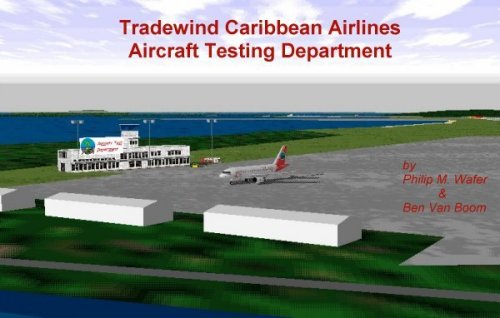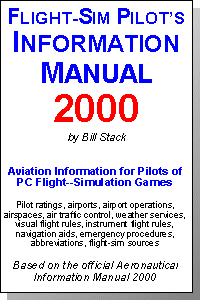

Flight-sim Pilots Information Manual 2000
PLEASE NOTE -
the book mentioned above is specifically for the users of
Personal Computer Flight Simulators only. It is NOT
a guide to flying in the real world!!

The book...
This is an updated version of
Bill Stacks' " Flight Simulator pilots Information
Manual" published in 1997. The basic tenet here is that it
is updated to the official (USA) Aeronautical Information Manual
2000.
But it is much more than that. The chapters have been expanded
from the original and new chapters developed out of expanded
issues. See the Training Associates Web Site for details.
Chapter 1 is a new chapter dealing with the concept of
"Pilot Certificates and Ratings". This is actually a
very good guideline in progressing oneself in flight proficiency
within flight-sims i.e. "learn to walk before you run!"
- acquire your flight sim "Private Pilots License"
first and work from there.
Chapter 4 is an expanded dissertation on Airspaces. Theoretical
Class F airspace is mentioned and also a few paragraphs on
Airways & Jetroutes with diagrams.
Chapter 5 "Air Traffic Control" has been expanded from
5 to 14 pages. I found a lot of useful information here. The
extra detail here is welcome as I find it useful in understanding
what to expect when I try MSFS98 internet flights using SATCO
services.
Chapter 6 "Weather Services" is new. It is a
concentration of the issue, whereas in the previous publication,
parts have been mentioned across various chapters.
The chapter on Visual Flight Rules has been expanded from 12 to
19 pages. The introduction is much longer than the previous
publication and makes the chapter very relevant. This time round
Bill breaks the general concepts into "Rules" for
flight-simmers, i.e. "Visual Flight Rule 2: Carry the
necessary equipment" etc and then proceeds to explain.
Brilliant!! This method is also carried through to the chapter on
Instrument Flight Rules.
The chapter on "Navigation Aids" is new and
concentrates solely on the aids of various types that help pilots
get safely from A to B, including radio, GPS and lighting.
New extra info in the appendices takes the form of conversion
tables (I've used these to good effect! Well done, Bill!) and
resources on the internet.
The book is in A5 format but obviously larger than its'
predecessor, increased from 85 pages to 172 pages. It is now ring
bound making it easy to keep open particular pages. The paper and
print appears better quality than before and I think the print
size is slightly larger. This combination makes the book much
easier to use and read.
The page numbering concept has changed from numbering in each
chapter to numbering from the beginning of the book This makes it
easier to navigate to specific items from the front or back
indices. Stick with this method please, Bill.
Conclusion:
The most striking part for me is the organisation of the chapters
on VFR & IFR. The Rules could be bullet points for safe
flying under each heading. It certainly is a quick way of
discerning whether one has everything covered before starting the
aircraft engine(s). Just for these chapters alone is it
worthwhile to update your copy of the Information Manual to the
1999 version.
Details of pricing etc can be obtained by checking out the
Topskills Web Site
PMW
Dublin, July '99.